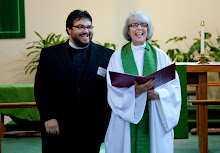In recent years, the new liturgical distinction of the "Assistant Minister" has emerged in our service books. However, in reality the liturgical role has been around nearly forever.
The assistant minister can be a member of the clergy or of the laity. There is little to no distinction between individuals according to age, sex, race, et cetera. It is however the title assistant minister that is new. The role and function of the deacon has been around since the first century. St. Steven – whose tale of martyrdom is found in Acts of the Apostles – is considered the proto-deacon, the first deacon. In those days of the Church, deacons had two main functions: (1) to serve as a worker for the poor, the orphan, the widow, and all the disenfranchised; and (2) to help assist in worship as a kind of worship leader halfway between an acolyte and the priest.
Unfortunately, Lutherans have continually divorced these two roles of the deacon. Today we have diaconal ministers, who play the social role of the deacon; and we have assistant ministers, who play out the liturgical function of the deacon.
I would love to see the state of the deacon restored in the Lutheran Church here in America, a role that once again combines the two roles into one person, one position.
